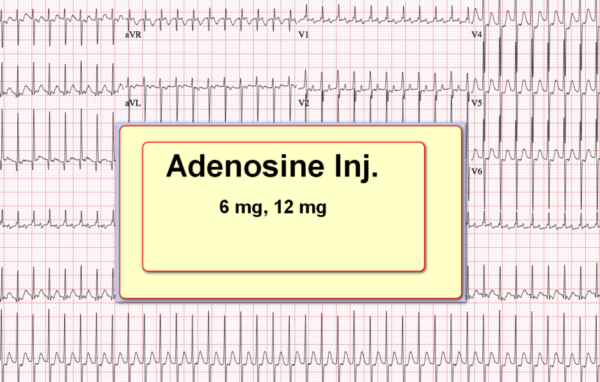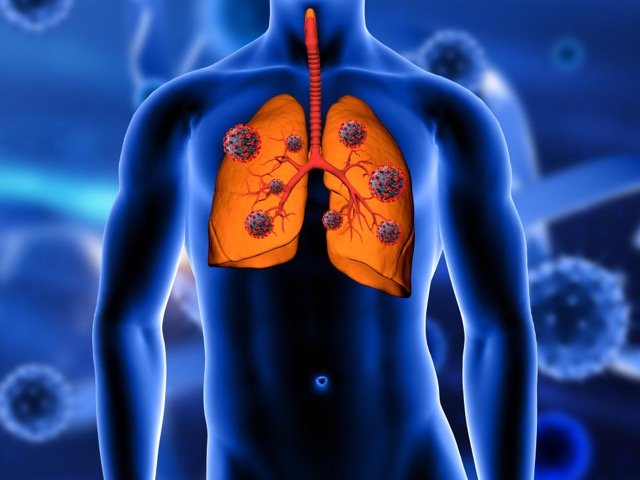Adenosine is a purine nucleoside base. It has many homeostatic functions in the body but is primarily used in patients with cardiac arrhythmias.
Adenosine Uses:
It is employed to treat paroxysmal supraventricular tachycardia (PSVT), which includes cases when auxiliary bypass tracts are involved (Wolff-Parkinson-White syndrome). Adenosine was shown to be less effective than verapamil in one research when used as an emergency therapy for supraventricular tachycardia [Ref].
Unlabeled uses of adenosine iv include:
- Stable, narrow-complex regular tachycardias;
- Unstable narrow-complex regular tachycardias
- Stable regular monomorphic, wide-complex tachycardia
- It is also used for vasodilator testing in pulmonary artery hypertension.
Adenosine receptors:
Adenosine receptors come in four main varieties: A1-AR, A2a-AR, A2b-AR, and A3-AR [Ref]. These receptors, which are G-protein coupled receptors, have a variety of roles in homeostasis in the body.
-
The A1-AR:
- These receptors are primarily present in the SA and AV nodes.
- The antiarrhythmic effects (treatment of supraventricular tachycardia) of adenosine and adenosine triphosphate are thought to be mediated by these receptors.
- These receptors also act as pain mediators (at peripheral, spinal, and supraspinal sites)
-
The A2a-AR:
- These receptors are present in the coronary arteries.
- The vasodilatory effects of adenosine for myocardial perfusion testing are mediated by these receptors when administered as an infusion.
- The A2a- AR antagonism may have a role in immune-mediated control of cancer progression
- These receptors might be the targets for the treatment of Alzheimer's and other neurodegenerative diseases like Parkinson's disease [Ref].
-
The A2b-AR:
- Drugs that act on these receptors have not been developed.
- Activation of these receptors might have a beneficial role in ischemia, vascular leakage, atherosclerotic diseases, diabetes, and acute lung injury.
-
The A3-AR:
- Activation of these receptors inhibits chemotaxis and neutrophil activation.
- Activation of A3-AR may have anti-inflammatory and anticancerous effects.
- Patients with rheumatoid arthritis and other inflammatory conditions including psoriasis are also being examined for the effects of the A3- AR activators.
Adenosine for hair growth:
The topical application of adenosine is used for healthy skin and hair growth.
Adenosine sleep:
It reduces the neuronal activity in the brain and thus reduces oxygen consumption by the brain. In animal studies, the extracellular levels of adenosine were higher in the sleeping mode compared to the awake brain. When the levels fall during sleep, the brain initiates the waking cycle.
Adenosine caffeine:
Caffeine blocks adenosine receptors non-selectively. Its role in the treatment of depression is thought to be secondary to the inhibition of adenosine receptors [Ref]. For optimal cardiovascular effects, caffeine should not be co-administered with adenosine. Patients with androgenic alopecia responded similarly to minoxidil and adenosine 0.75% solution. Adenosine is applied topically for cosmetic purposes as a 0.1% cream or 1% dissolvable film. It makes the skin more supple and reduces wrinkles.
Adenosine Dose in Adults
Adenosine dose in Paroxysmal supraventricular tachycardia (PSVT):
- 6 mg delivered intravenously in a brief (1–2 second) burst via a peripheral line
- A quick intravenous push of a second dose of 12 mg may be administered if the first dose does not take effect within 1-2 minutes.
- If necessary, the dose may be repeated up to a maximum of 12 mg each dose.
- After each dose of the medication, a 20 ml intravenous flush with normal saline is recommended.
NOTE:
The initial dose should be reduced to 3 mg if:
- Dipyridamole or carbamazepine (Tegral) are being administered to the patient.
- The medication is given through a peripheral line to the patient, who has a transplanted heart.
Adenosine use in pharmacologic stress testing:
- Using a syringe or volumetric infusion pump, administer 140 mcg/kg/minute as a continuous intravenous infusion through a peripheral intravenous line for 6 minutes.
- There is a 0.84 mg/kg overall dosage.
- At three minutes into the infusion, thallium-201 is administered.
Adenosine use as an acute vasodilator testing in pulmonary artery hypertension:
- As a first intravenous infusion, administer 50 mcg/kg/min.
- Every two minutes, the dose is increased by 50 mcg/kg/minute, up to a maximum of 500 mcg/kg/minute or 250 mcg/kg/minute.
- It carefully evaluates the vasodilator reaction.
Adenosine Dose in Children
Adenosine injection dose in Paroxysmal supraventricular tachycardia (PSVT):
-
Neonates:
- A quick intravenous first dose of 0.05–0.1 mg/kg is administered.
- Increase the dose by 0.05-0.1 mg/kg increments every 1-2 minutes to a maximum single dose of 0.3 mg/kg or until termination of
- PSVT if it is not effective within 1-2 minutes.
-
Infants and Children:
- 0.1 mg/kg as a fast intravenous or intraosseous injection up to a dose of 6 mg.
- If ineffective, administer 0.2 mg/kg (maximum dose of 12 mg)
Adenosine dose as per the manufacturer's recommendations:
-
Infants, Children, and Adolescents <50 kg:
- 0.05–0.1 mg/kg administered intravenously quickly.
- If it doesn't start working after 1-2 minutes, up the dose by 0.05-0.1 mg/kg increments every 1-2 minutes, up to a single dose of 0.3
- mg/kg at its highest, or until the PSVT stops.
-
Children and Adolescents ≥50 kg and Adults:
- Pushing 6 mg intravenously.
- If it doesn't work within 1-2 minutes, 12 mg may be administered.
- If necessary, the dose (12 mg) may be given again.
Adenosine Dosage in kidney disease:
- Any recommendations regarding dose adjustment has not been provided in the manufacturer's labeling.
- However, adenosine is not eliminated via the kidneys.
Adenosine Dosage in liver disease:
- Any recommendations regarding dose adjustment has not been provided in the manufacturer's labeling.
- However, since, adenosine is not hepatically eliminated.
How to administer?
1-2 seconds should be spent administering as an intravenous push at a peripheral I.V. site as close to the trunk as possible (not in the lower arm, hand, lower leg, or foot).
- After the injection, a quick flush with regular saline should be administered (20 ml of adults, 5-10 ml for children).
- It is advised to use two syringes, one loaded with an adenosine dose and the other flushed with regular saline.
- Reduce the initial dose if supplied to adults through central line.
It is compatible and Stable in D 5 LR, D 5 W, LR, and NS.
Adenosine Pregnancy Risk Factor C
- It has not yet been tested in pregnancy.
- ACLS guidelines recommend that it be used during pregnancy. Breast milk excretion is unknown
Adenosine Contraindications
- Hypersensitivity to the drug
- Second- and third-degree AV block
- Sick sinus
- Use in patients with atrial fibrillation/flutter
- Asthma
Warnings and Precautions
- Wolff Parkinson White patients have had reports of atrial fibrillation, flutter and other symptoms.
- It has been associated with the reports of AV nodal conduction blockages, heart blocks, and prolonged fatal cases asystole.
- Patients with hypotension, autonomic dysfunction and carotid-stenosis should not use it.
- It can cause vasodilation that leads to hypotension. It is more effective when it is administered as a continuous infusion rather than as a single bolus.
- It can cause polymorphic ventricular rhythmic tachycardia and proarrhythmic effects. It is more common to cause ventricular and atrial ectopics.
- Patients with hypokalemia or hypomagnesemia, as well as heart transplant recipients, should not use it.
- When utilising vasodilator tests in pulmonary hypertension, patients with concurrent heart disease and pulmonary vein occlusive illness should exercise caution.
Drug therapy issues that are concurrent:
- Avoid caffeine and theophylline at least 12 hours before pharmacologic stress testing. Caffeine can inhibit the effects of adenosine.
- Dipyridamole and carbamazepine enhance adenosine's actions.
- Before pharmacologic stress testing, dipyridamole-containing medications must be withheld for 24 hours
- It should be used with caution in patients using drugs that slow AV node conduction like digoxin and verapamil.
Adenosine side effects (common):
- Angina
- apprehension,
- arrhythmia (discontinue if asystole or severe bradycardia occur),
- AV block,
- dizziness,
- dyspnoea,
- flushing,
- headache,
- nausea,
- sinus pause
Adenosine side effects (uncommon):
- Blurred vision,
- hyperventilation,
- metallic taste,
- palpitation,
- sweating,
- weakness
Adenosine side effects (rare):
- Bronchospasm,
- injection-site reactions,
- transient worsening of intracranial hypertension,
- cardiac arrest,
- convulsions,
- hypotension
- respiratory failure
- syncope, and
- vomiting.
Monitoring Parameters:
- ECG
- Heart rate, and
- Blood pressure
Adenosine Mechanism of action as an Antiarrhythmic agent:
- It shortens the period that information travels through the AV node and blocks reentry paths through the node. This makes the sinus rhythm normal again.
- Myocardial perfusion scintigraphy uses adenosine
- It increases coronary blood flow and causes coronary vasodilation.
- The number of stenotic coronary arteries has decreased or not increased at all.
- The stenotic coronary vessels will have a lower level of thalium-201 uptake, indicating areas of inadequate blood flow.
It starts working quickly and finishes working quickly.
Its elimination half-life is under 10 seconds.
It is converted to inosine, adenosine monophosphates (AMP), and hypoxanthine in the blood and tissues.
Adenosine brand names in Pakistan
- Adenocor
Adenosine Brand Names International:
- Adenocard
- Adenocor
- Adenoject
- Adenoscan
- Adenosina Biol
- Adenozer
- Adrekar
- Cardimax
- Cardiovert
- Krenosin
- Krenosine
- Tricor
Adnenosine Brand Names in the U.S.
- Adenocard® IV;
- Adenoscan®
Adenosine Brand Names in Canada
- Adenocard®;
- Adenosine Injection, USP;
- PMS-Adenosine
Rivaroxaban - a novel oral anticoagulant







